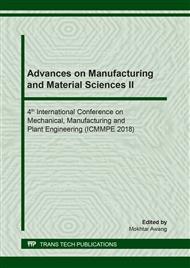p.11
p.17
p.22
p.30
p.38
p.46
p.53
p.62
p.67
Effects of Vibratory Disc Milling Time on the Physiochemical and Morphological Properties of Coal Fly Ash Nanoparticles
Abstract:
In this study, the mechanical disc milling of coal fly ash (CFA) produced by ESKOM thermal station in South Africa has been investigated. The present work covers the effects of milling time on the characteristics such as crystal phases, particle sizes, morphology and physiology of the powder. The produced nanoparticle powders were characterized by SEM-EDX, XRD, and XRF. The milling time was carried out at (t=0, 20, 40, and 60 minutes) at a constant milling speed of 940 rpm. The results showed that mean area of the particles of the particle sizes increased from 75 µm size to approximately 200 nm which revealed that there was 62.5 % increase in the number of particle size as a result of the disintegration of the area of particle sizes. The crystal phases detected by the XRD in CFA are hexagonal, orthorhombic, rhombohedral and anorthic. XRD analysis showed that the most dominant minerals in coal fly ash are Quartz (SiO2), Mullite (Al2.32Si0.68O4.84), Sillimanite (Al2(SiO4)O, Calcite high (CaCO3), Hematite (Fe2O3), Microcline (KAlSi3O8). It was also revealed by EDX that the main elemental compositions present in CFA are silicon, aluminium, calcium, iron, titanium and magnesium. It was established in the study that the duration of the milling affects volume, surface area, particle size, pore size distributions, as well as the microstructure
Info:
Periodical:
Pages:
38-45
Citation:
Online since:
March 2019
Authors:
Keywords:
Price:
Сopyright:
© 2019 Trans Tech Publications Ltd. All Rights Reserved
Share:
Citation:


